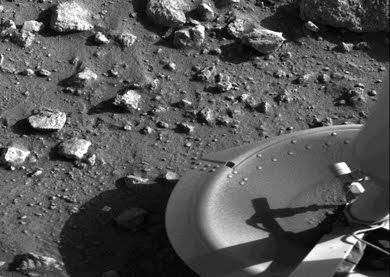
From the perennial Mars hoax to Ray Bradbury's The Martian Chronicles, no other body in our solar system has so captured the human imagination. Throughout history mankind has gazed into the night sky wondering what civilizations awaited those who landed on the Red Planet's surface. The novels of Burroughs and others tout the planet's allure and films have warned humanity of its dangers.
In 1965, the Mariner 4 spacecraft sent the first images of another planet to waiting scientists on Earth. Since that image, the Red Planet has revealed a world strangely familiar, yet challenging. Each time scientists feel close to understanding Mars, new discoveries send them back to the drawing board to revise existing theories.
In the 35 years since NASA launched Viking 1 on Aug. 20, 1975, the ambitious mission only whetted the scientific world and public's enthusiasm for future space exploration. In the ensuing years, NASA has launched the Phoenix Mars Lander, Mars Reconnaissance Orbiter and Mars Exploration Rovers, among others. Perhaps the most successful of these missions is Mars Exploration Rovers. Launched in June and July 2003, respectively, Spirit and Opportunity landed on Mars each for a 90-day mission that continues after more than 6 years.
For centuries, scientists wondered if Mars might be covered with vegetation -- or even inhabited by intelligent beings. Today, we know Mars to be quite different. It is a frozen desert world with now silent volcanoes and deep canyons. Polar ice caps expand and contract with the Martian seasons.
While the story began years earlier, it culminated in August and September 1975 with the launch of two large, nearly identical spacecraft from Cape Canaveral, Fl. Vikings 1 and 2, named for the fearless Nordic explorers of Earth, finally give humans a close-up look at this alien world.
Viking 1 and 2, each consisting of an orbiter and a lander, became the first space probes to obtain high resolution images of the Martian surface; characterize the structure and composition of the atmosphere and surface; and conduct on-the-spot biological tests for life on another planet.
Among the discoveries about Mars over the years, one stands out above all others: the possible presence of liquid water, either in its ancient past or preserved in the subsurface today. Water is key because almost everywhere water is found on Earth, so is life. If Mars once had liquid water, or still does today, it's compelling to ask whether any microscopic life forms could have developed on its surface.
Viking 1 arrived at Mars on June 19, 1976. On July 20, 1976, the Viking 1 lander separated from the orbiter and touched down at Chryse Planitia. Viking 2 was launched Sept. 9, 1975, and entered Mars orbit Aug. 7, 1976. The Viking 2 lander touched down at Utopia Planitia on Sept. 3, 1976.
In 1965, the Mariner 4 spacecraft sent the first images of another planet to waiting scientists on Earth. Since that image, the Red Planet has revealed a world strangely familiar, yet challenging. Each time scientists feel close to understanding Mars, new discoveries send them back to the drawing board to revise existing theories.
In the 35 years since NASA launched Viking 1 on Aug. 20, 1975, the ambitious mission only whetted the scientific world and public's enthusiasm for future space exploration. In the ensuing years, NASA has launched the Phoenix Mars Lander, Mars Reconnaissance Orbiter and Mars Exploration Rovers, among others. Perhaps the most successful of these missions is Mars Exploration Rovers. Launched in June and July 2003, respectively, Spirit and Opportunity landed on Mars each for a 90-day mission that continues after more than 6 years.
For centuries, scientists wondered if Mars might be covered with vegetation -- or even inhabited by intelligent beings. Today, we know Mars to be quite different. It is a frozen desert world with now silent volcanoes and deep canyons. Polar ice caps expand and contract with the Martian seasons.
While the story began years earlier, it culminated in August and September 1975 with the launch of two large, nearly identical spacecraft from Cape Canaveral, Fl. Vikings 1 and 2, named for the fearless Nordic explorers of Earth, finally give humans a close-up look at this alien world.
Viking 1 and 2, each consisting of an orbiter and a lander, became the first space probes to obtain high resolution images of the Martian surface; characterize the structure and composition of the atmosphere and surface; and conduct on-the-spot biological tests for life on another planet.
Among the discoveries about Mars over the years, one stands out above all others: the possible presence of liquid water, either in its ancient past or preserved in the subsurface today. Water is key because almost everywhere water is found on Earth, so is life. If Mars once had liquid water, or still does today, it's compelling to ask whether any microscopic life forms could have developed on its surface.
Viking 1 arrived at Mars on June 19, 1976. On July 20, 1976, the Viking 1 lander separated from the orbiter and touched down at Chryse Planitia. Viking 2 was launched Sept. 9, 1975, and entered Mars orbit Aug. 7, 1976. The Viking 2 lander touched down at Utopia Planitia on Sept. 3, 1976.
